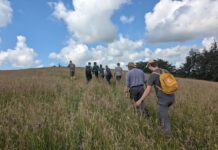
In the wake of the publication of the Government’s new National Planning Policy Framework (NPPF) and the long-awaited 25-Year Environment Plan, Local Planning Authorities (LPAs) are in urgent need of clear strategies to tackle increasingly stringent biodiversity requirements in their local plans, says ecological planning consultancy EPR.
The firm has highlighted that, with local authorities under pressure to allocate sites for housing development, very few have been able to respond with Local Plans that have measurable targets for biodiversity or have the ability to provide clear updates on progress and development.
The NPPF is clear about the need for LPAs to maintain and enhance biodiversity in a demonstrable way. Not only does it dictate that plans should promote the restoration of priority habitats, ecological networks and the recovery of priority species, but they must also pursue opportunities to secure measurable net gains for biodiversity (174b).
The 25-Year Environment Plan outlines how a ‘Nature Recovery Network’ may be used to boost the biodiversity and environmental character of an area. However, specific guidelines for delivery of such a network are currently lacking.
In order to help councils reconcile these requirements with declining budgets and new targets for new housing allocation, EPR has launched a service entitled ‘Planning for Wildlife’. The aim of the initiative is to enable LPAs to work with developers to help deliver projects that avoid or mitigate cumulative harm on habitats, and clearly provide the opportunities for biodiversity net gain that arise from housing development.
To achieve this, ‘Planning for Wildlife’ promotes collaboration with local wildlife organisations and Biological Records Centres, which have demonstrable skills and a long-term vested interest in delivering and monitoring biodiversity. This ensures, first of all, that the complicated process of managing wildlife is undertaken by those most likely to achieve it; secondly, that data is available to all stakeholders and, finally, that there is ongoing support for organisations with local skills and expertise.
The service covers all aspects of a comprehensive ‘Nature Recovery Network’, including:
• Analysing existing data using GIS, to identify key areas for protection and opportunities for restoration;
• Coordinating consultation with stakeholders, to ensure that all data is captured and maximise engagement;
• Agreeing a joint vision and setting achievable and measurable targets
• Identifying measures to avoid impacts on European Protected Sites and other important ecological features
• Measures to restore and create habitat networks
• Measures to restore and create ‘dark corridors’ for nocturnal wildlife
• Strategic measures for the protection of translocated common reptiles
• Engagement with stakeholders to deliver effective monitoring, review and progress reporting
• Production of advice for developers on how to deliver net gain through their Green Infrastructure and Sustainable Urban Drainage (SUDS)
Other strategies and approaches may be included according to the unique characteristics of the area in question. In providing this comprehensive, targeted guidance, ‘Planning for Wildlife’ enables LPAs to develop recovery networks that stand up to legal challenge, as well as scrutiny at Examinations in Public and Public Inquiries.
“Local authorities are under more pressure than ever to demonstrate their commitment to creating biodiversity ‘net gains’ as part of their local plans,” said Karen Colebourn, Director, EPR. However, despite this increasing focus, guidance on how to achieve biodiversity gains through an actionable Nature Recovery Network in practice has to date been limited. And while there is no ‘one-size-fits-all’ approach for every council, ‘Planning for Wildlife’ brings together a number of common principles to ensure a successful – and measurable – means of fulfilling biodiversity requirements.”








